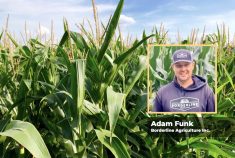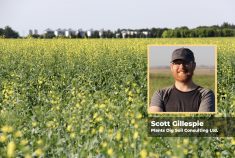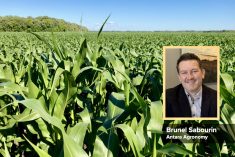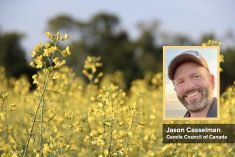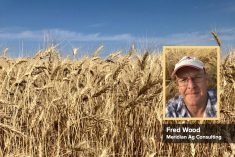Growers are challenged to achieve the highest yields with the least inputs, and more agronomists, advisors, technicians and researchers are interested helping them focus on specific soil and plant needs such as what macronutrients and micronutrients are needed, and when and where is best to use them.
The 2022 growing season was the first year for a project to study mid-season corn tissue sampling to determine whether it would boost yield. There has been past late-season tissue sampling to assess nutrient levels from the previous growing season, but this mid-season testing was to assess potential to boost the current crop’s yields.
“Interest was sparked in 2021 when some nutrient deficiencies related to zinc (Zn) were discovered at corn tassel (VT),” says Danny Jefferies, precision ag specialist with Deveron, based in Chatham, Ont. “The goal of this project is to be long-term, ultimately developing a protocol which delivers actionable insights resulting in yield and profitability increases for our clients.”
Read Also

Producers aren’t panicking over tariffs and trade threats
The influence of tariff and trade uncertainity on farm business decisions.
Deveron worked with four farmer collaborators across Ontario, and had support and partial funding from the Upper Thames Conservation Authority. They used precision tools available to the farmer participants, along with measurements from plant tissue analysis by A&L Laboratories Canada in London.
Four samples were collected from each farm, June 13 (V5), June 27 (V7), July 11 (V10) and August 24 (R4). The goal was to benchmark conditions earlier in the season and then track responses from later treatments to determine the best chance at targeting applications for optimum effect. It was especially important to understand corn nutrient uptake timing, and rates, partitioning and remobilization, keeping in mind that most uptake increases quickly after V6.
“We also wanted to be sure to have sampling around or just prior to VT timing to allow for evaluation of zinc uptake and perhaps capitalize on a sprayer pass already occurring with fungicide applications,” says Jefferies. “Ideally, if a budget was unlimited, additional samples and tracking over tighter intervals would be beneficial.”

The process
Samples were collected from two locations in each field, chosen based on yield potential. Jefferies says they used historical yield maps to select traditionally high-yielding areas, and then a low- to medium-yielding area. They deliberately avoided areas with poor yields resulting from environmental factors such as standing water or eroded knolls. The idea was to push low to medium areas into higher yields based on limiting factors based on nutrition rather than environment.
“We collected a baseline soil sample at the same time and location of our first tissue sample collection. This provided us a measure of background soil fertility at that location. We also did multiple collections at each site, including a tissue and a sap test collection.”
For the sap testing, they collected a sample from the lower leaves (older growth) and upper leaves (newer growth). Based on observations from the tissue test, they evaluated and made recommendations to the farmer clients, including choices for product applications. Then they evaluated the nutrient’s uptake, using additional post-application tissue and sap tests to find changes in those levels.
“The collaborators are top-end managers; all fields are well tiled, well managed for soil health and well fertilized with good background fertility,” says Jefferies. “The pursuit of micronutrients is further down the food chain and a potential ‘missing link’ in our 2022 data set will be the variable of moisture.”
He says generally, all site locations lacked moisture during July, with expected impacts on the corn’s nutrient uptake.
Another part of the project — which may need a more in-depth examination — relates to the choice of foliar products. There are plenty of foliar nutrient solutions available, including chelated and fulvic acids. Some of the collaborators also apply tank mixes with different adjuvants. Jefferies believes there are differences in how products perform in terms of plant uptake and the responses he saw in the tissue and sap tests.
Cleanliness is important
Jefferies says they took great lengths to ensure samples were taken in the cleanest conditions, avoiding contamination from dust or soil on the tissues or contact with fertilizers, salts or grease.
“We also made sure to sample after applications to make sure we weren’t in the field immediately or shortly after the product was applied. It was important not to sample when there was still moisture on the leaves, as this could influence the sap test results. We took care to store samples cool and transport them in a cooler — quick delivery to the laboratory was also important.”

It’s been suggested that mid-season tissue tests offer a greater return on investment for higher-value crops such as potatoes, but Jefferies maintains there is certainly value to tissue testing in cash crops. The key is to conduct the sampling strategically and economically — to “fry the big fish first” and ensure they have the background fertility well managed, then sample in multiple locations using satellite imagery or historical yield data.
The testing in this program assessed the entire spectrum of macro- and micronutrients within the leaf. The sap test also analyzed sugars, pH and nitrogen conversion efficiency (NCE), which illustrates the plant’s efficiency in converting nitrogen to usable forms like amino acids and proteins. They also observed how certain nutrients behave once in the plant tissue.
“Boron, even though it’s mobile within the soil profile, is immobile within the plant,” explains Jefferies. “We saw an uptick in boron levels post-application, but sampling a couple of weeks later, our levels were back down as the nutrient didn’t move to the new growth. This really illustrated the importance of hitting an ideal window for timing when the nutrient is most in need.”
Environmental spinoffs
The capability and efficiency of plants to use available or applied nutrients is a growing concern outside of agriculture because of environmental effects, but research into doing more with less also offers farmers the opportunity to save on expensive fertilizer and other inputs.
The Upper Thames River Conservation Authority (UTRCA) has been working with Deveron staff for several years, examining the impact of cover crops from environmental, economic and agronomic perspectives. The environmental impact was reason for the UTRCA’s interest for this tissue-testing project.
“As we promote practices, we need to also consider the impact to the whole farming operation,” says Tatianna Lozier, stewardship services co-ordinator with the UTRCA. “The economics of soil health, water quality or climate change practices continue to be at the forefront of conversations these days. Deveron staff have provided valuable insight into the type of data we should collect to answer farmer-led questions about their fields and have been invaluable in analyzing the data.”
The authority has participated in past studies investigating potential nutrient loss from stream vegetation or cover crops. Tile drainage and surface runoff, especially of phosphorus, have always been of concern for the UTRCA. For this project, they included tissue sampling based on recommendations from Deveron staff to provide potential insight on differences in yields with or without cover crops.
Lozier says this kind of research offers the opportunity for understanding from all sides — stewardship, farming and research/service providers.
“Our stewardship staff will continue to learn and expand our knowledge of precision practices, but ultimately we rely on partnerships with those who have expertise outside of our organization. Working in partnership with companies like Deveron allows the opportunity for a number of different perspectives on an issue.”
The project is slated to continue in 2023, with several challenges. Lozier says they’re looking for more collaborators, but Jefferies says tissue testing is labour-, time- and equipment-intensive, and labour availability is at an all-time low. They also need further validation that their recommendations are leading to higher yields, which could help convince growers of the value of testing and specific nutrient applications.
Other resources:




